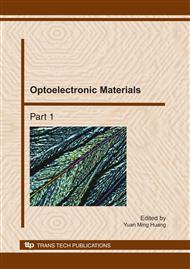[1]
Y. Chen, B. Liu, M. Kirm, Z. Qi, C. Shi, M. True, S. Vielhauer and G. Zimmerer: J. Lumin. Vol. 118 (2006), p.70.
Google Scholar
[2]
Y. Chen, X. Cheng, M. Liu, Z. Qi and C. Shi: J. Lumin. Vol. 129 (2009), p.531.
Google Scholar
[3]
Y. Murayama, N. Takeuchi, Y. Aoki and T. Matsuzawa: US. Patent. No. 5 424 006 (1995).
Google Scholar
[4]
Z. Xiao and Z. Xiao: US. Patent. No. 6 093 346 (2000).
Google Scholar
[5]
Q. Fei, C. Chang and D. Mao: J. Alloys Compd. Vol. 390 (2005), p.133.
Google Scholar
[6]
A.A.S. Alvani, F. Moztarzadeh andA.A. Sarabi: J. Lumin. Vol. 114 (2005), p.131.
Google Scholar
[7]
G.J. Alwar, C.P. Joshi, S. V Moharil, S.M. Dhopte, P.L. Muthal and V.K. Kondawar: J. Lumin. Vol. 129 (2009), p.1239.
Google Scholar
[8]
H. Wu, Y. Wang, Y. Hu, L. Deng and W. Xie: J. Phys. D: Appl. Phys. Vol. 42 (2009), p.125406.
Google Scholar
[9]
L. Lin, M. Yin, C. Shi and W. Zhang: J. Alloys Compd. Vol. 455 (2008), p.327.
Google Scholar
[10]
A. Komero, K. Uematsu, K. Toda and M. Sato: J. Alloys Compd. Vol. 408-412 (2006), p.871.
Google Scholar
[11]
P. Dorenbos: Phys. Rev. B Vol. 62 (2000), p.15640.
Google Scholar
[12]
P. Dorenbos: Phys. Rev. B Vol. 62 (2000), p.15650.
Google Scholar
[13]
R. Chen, Y. Wang, Y. Hu, Z. Hu and C. Liu: J. Lumin. Vol. 128 (2008), p.1180.
Google Scholar
[14]
S.K. Sharma, S.S. Pitale, M.M. Malik, M.S. Qureshi and R.N. Dubey: J. Alloys Compd. Vol. 482 (2009), p.468.
Google Scholar
[15]
H. Kubo, H. Aizawa, T. Katsumata, S. Komuro and T. Morikawa: J. Cryst. Growth Vol. 275 (2005), p. e1767.
Google Scholar
[16]
P. Dorenbos: J. Electrochem. Soc. Vol. 152 (2005), p. H107.
Google Scholar
[17]
Y. Wang and L. Wang: J. Appl. Phys. Vol. 101 (2007), 053108.
Google Scholar
[18]
T. Aitasalo, J. Hölsä, H. Jungner, M. Lastusaari and J. Niittykoski: J. Phys. Chem. B Vol. 110 (2006), p.4589.
Google Scholar
[19]
H. Wu, Y. Hu, Y. Wang and Z. Mou: J. Lumin. Vol. 130 (2010), p.127.
Google Scholar
[20]
R. Chen: J. Electrochem. Soc. Vol. 116 (1969), p.1254.
Google Scholar
[21]
T. Aitasalo, J. Hölsä, H. Jungner, M. Lastusaari, J. Niittykoski and G. Spano: J. Alloys Compd. Vol. 374 (2004), p.56.
DOI: 10.1016/j.jallcom.2003.11.064
Google Scholar


